
Spring & Summer 2010
Up Cottage Way
It was already quite mild when we (Paul and Kitty Antonik Wakfer) arrived back in Ontario at the beginning of May, so we carried out plans quickly to continue our apple tree rescuing at Leeson Farm. The early warmth had also brought out the black flies earlier than usual, so we had to wear our bug jackets right from the get-go.
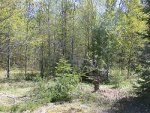
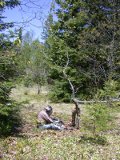 Several small and medium sized trees, evergreens and deciduous, were growing right near this small apple tree. It had sent out a few very long branches seeking the sunlight and had produced a few apples on them. Since there are no large trees nearby we hope that this one will shape out and produce more in the future.
Several small and medium sized trees, evergreens and deciduous, were growing right near this small apple tree. It had sent out a few very long branches seeking the sunlight and had produced a few apples on them. Since there are no large trees nearby we hope that this one will shape out and produce more in the future.
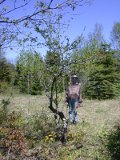 This is a really strange apple tree - at least neither of us had ever seen any tree do what is seen on this one. Close-ups show one branch of this tree grown into another.
This is a really strange apple tree - at least neither of us had ever seen any tree do what is seen on this one. Close-ups show one branch of this tree grown into another.
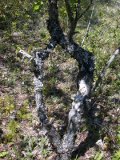 The left branch of the main trunk has divided itself and then grown into the larger portion of the right main trunk branch.
The left branch of the main trunk has divided itself and then grown into the larger portion of the right main trunk branch.
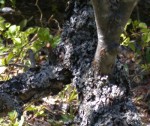
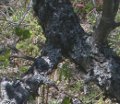 The left (smaller) moss covered branch is joined with the right (larger) branch, also moss covered. The end of the smaller branch has become grafted onto the larger... amazing!
The left (smaller) moss covered branch is joined with the right (larger) branch, also moss covered. The end of the smaller branch has become grafted onto the larger... amazing!
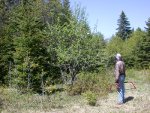 A few blossoms can be seen on this apple tree that was already mostly free of impinging trees. On one of our later visits this year we did remove the evergreen on the left and a few deciduous saplings near the apple tree. We're hopeful for more blossoms and apples next year.
A few blossoms can be seen on this apple tree that was already mostly free of impinging trees. On one of our later visits this year we did remove the evergreen on the left and a few deciduous saplings near the apple tree. We're hopeful for more blossoms and apples next year.
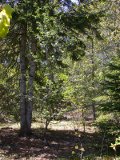 The base of this poor thing could barely be seen last year - just a few branches sticking out among several small to medium sized trees, but with a few apples! So last Autumn we cleared out a lot and left the very long horizontal branch supported. We didn't want to remove too much from the apple tree and irreparably shock it. On a later visit we shortened the horizontal branch at the point where the support is showing on this photo - several small branchings upward had developed and good shaping of the tree looks promising. At the beginning of Autumn we also removed a few more branches on the left of the large evergreen and cut down the evergreen seen in the at the photo, both to maintain acceptable light for the apple tree.
The base of this poor thing could barely be seen last year - just a few branches sticking out among several small to medium sized trees, but with a few apples! So last Autumn we cleared out a lot and left the very long horizontal branch supported. We didn't want to remove too much from the apple tree and irreparably shock it. On a later visit we shortened the horizontal branch at the point where the support is showing on this photo - several small branchings upward had developed and good shaping of the tree looks promising. At the beginning of Autumn we also removed a few more branches on the left of the large evergreen and cut down the evergreen seen in the at the photo, both to maintain acceptable light for the apple tree.
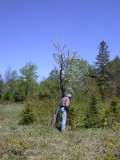 This blossom laden apple tree is on the edge of the large open area that is used by some residents of Harcourt Park as a skeet range. It appears to have suffered from broken branches in the past - possibly from bears (or humans) trying to reach apples. We decided that its perseverance deserves active rescue work - removal of close-by trees and pruning for more blossoms/apples.
This blossom laden apple tree is on the edge of the large open area that is used by some residents of Harcourt Park as a skeet range. It appears to have suffered from broken branches in the past - possibly from bears (or humans) trying to reach apples. We decided that its perseverance deserves active rescue work - removal of close-by trees and pruning for more blossoms/apples.
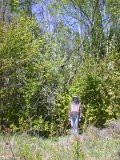 If you look close you can identify apple blossoms on several branches among a lot of young maples and other deciduous trees. Kitty thought it would be good to record an apple tree before anything was done towards "rescuing" it.
If you look close you can identify apple blossoms on several branches among a lot of young maples and other deciduous trees. Kitty thought it would be good to record an apple tree before anything was done towards "rescuing" it.
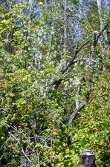 Here's a closeup just to make sure everyone can see the apple blossoms.
Here's a closeup just to make sure everyone can see the apple blossoms.
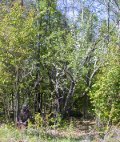 About 90 minutes later we had made noticeable progress towards removing much of the smaller impinging trees. We did a bit more this same day and then finished the task a couple weeks later, at which time we moved onto another tree in this same general area.
About 90 minutes later we had made noticeable progress towards removing much of the smaller impinging trees. We did a bit more this same day and then finished the task a couple weeks later, at which time we moved onto another tree in this same general area.
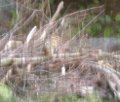 Kitty decided to keep this photo even though it's blurred because the chipmunk is so groundsquirrel-like in its pose on top of the branches on our brush pile.
Kitty decided to keep this photo even though it's blurred because the chipmunk is so groundsquirrel-like in its pose on top of the branches on our brush pile.
 June 26th brought with it just the right amount of cloud cover and moisture to create a spectacular sunset on Little Straggle Lake. The mist among the tops of the trees on this portion of non-human occupied shoreline beyond "the point" gives the scene a certain "other world" image.
June 26th brought with it just the right amount of cloud cover and moisture to create a spectacular sunset on Little Straggle Lake. The mist among the tops of the trees on this portion of non-human occupied shoreline beyond "the point" gives the scene a certain "other world" image.
Kitty and Paul were sitting on their dock, enjoying their fruit salad and looking at the fish, in the late afternoon of July 2 when both of them realized that there were several large spider webs in this area of the cedar tree, rocks and dock itself.
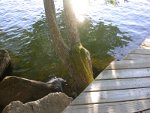
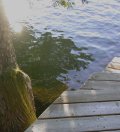 One web extends from the cedar tree trunk to the point of the 2nd dock step. Repair work appeared to be underway by a spider - it had been a breezy afternoon.
One web extends from the cedar tree trunk to the point of the 2nd dock step. Repair work appeared to be underway by a spider - it had been a breezy afternoon.
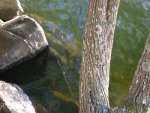 The webs here may be more recent since there seemed to be little damage. The one from the left trunk does not end in mid-air, but extends out and down to the rock on the left.
The webs here may be more recent since there seemed to be little damage. The one from the left trunk does not end in mid-air, but extends out and down to the rock on the left.
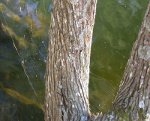 The detail of the webs was fascinating to examine - the radial threads appear thicker than the circumferential ones, and the initial "tacking" ones are thickest of all we saw. While watching the repair work done on some, we also noted that the spider's speed was actually quite fast when doing the circumferential webbing.
The detail of the webs was fascinating to examine - the radial threads appear thicker than the circumferential ones, and the initial "tacking" ones are thickest of all we saw. While watching the repair work done on some, we also noted that the spider's speed was actually quite fast when doing the circumferential webbing.
The characteristic sound of woodpecker tapping on wood got our attention on July 9. From the kitchen and sidedoor windows we observed a pair of pileated woodpeckers - which we thought at the time might possibly be the same ones that have visited our yard in the past. However in doing more research online, Kitty concludes that this is a female parent with a male fledgling.
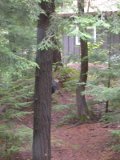 The young male - distinguished by the red crest that starts at the beak, rather than further back as on females - spent a few early moments on one of our live trees.
The young male - distinguished by the red crest that starts at the beak, rather than further back as on females - spent a few early moments on one of our live trees.
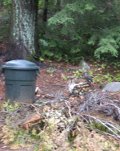 Something on the ground behind the garbage pail - used for holding small mulched items for either fire tinder or, if green, distributing in low wooded areas of the property - has the attention of one of them. It's not clear from this pic which bird is which, but it becomes clear from the following photos that the one on the right is male and the worker behind the pail is female.
Something on the ground behind the garbage pail - used for holding small mulched items for either fire tinder or, if green, distributing in low wooded areas of the property - has the attention of one of them. It's not clear from this pic which bird is which, but it becomes clear from the following photos that the one on the right is male and the worker behind the pail is female.
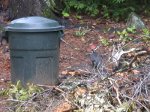 There is actually much activity going on behind the pail - chips can be seen flying in all directions, but the young male just waits and supposedly is learning. Seems like he ought to be paying a bit closer attention :)
There is actually much activity going on behind the pail - chips can be seen flying in all directions, but the young male just waits and supposedly is learning. Seems like he ought to be paying a bit closer attention :)
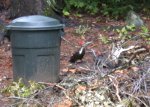
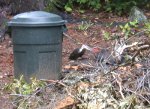 The first of these 2 photos shows the different red crests and makes it clear that the bird doing the work is female. From the online resource Kitty learned that the adults care for fledglings until at least September, also teaching them how to acquire food. This male is therefore on a learning expedition with Mom and gets fed in the process. The female woodpecker approaches the young male and then in the 2nd shot is seen pushing the regurgitated bugs into his open mouth.
The first of these 2 photos shows the different red crests and makes it clear that the bird doing the work is female. From the online resource Kitty learned that the adults care for fledglings until at least September, also teaching them how to acquire food. This male is therefore on a learning expedition with Mom and gets fed in the process. The female woodpecker approaches the young male and then in the 2nd shot is seen pushing the regurgitated bugs into his open mouth.
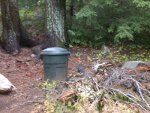 The fledgling male is back to waiting while his mother resumes chipping and bug removal. Maybe he's observing for predators...
The fledgling male is back to waiting while his mother resumes chipping and bug removal. Maybe he's observing for predators...
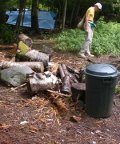 About 45 minutes later when we realized we'd not heard the pecking for several minutes, we went outside to see what remained of the wood behind the garbage pail before proceeding on to berry picking - of which there were a lot this summer of 2010.
About 45 minutes later when we realized we'd not heard the pecking for several minutes, we went outside to see what remained of the wood behind the garbage pail before proceeding on to berry picking - of which there were a lot this summer of 2010.

 |
|
 |
MoreLife is Always "Under Construction"
Initially posted 10/17/2010
Page last updated 10/17/2010
Any questions, comments or suggestions regarding the content of this website
should be addressed at MoreLife Yahoo.
For comments on webpage format, contact Kitty
Antonik Wakfer

 Several small and medium sized trees, evergreens and deciduous, were growing right near this small apple tree. It had sent out a few very long branches seeking the sunlight and had produced a few apples on them. Since there are no large trees nearby we hope that this one will shape out and produce more in the future.
Several small and medium sized trees, evergreens and deciduous, were growing right near this small apple tree. It had sent out a few very long branches seeking the sunlight and had produced a few apples on them. Since there are no large trees nearby we hope that this one will shape out and produce more in the future.

























